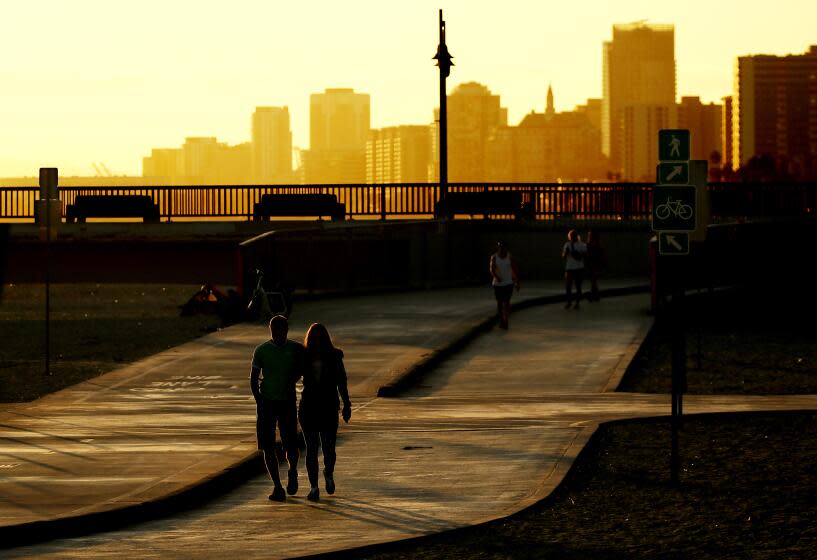A fall heat wave is hitting California. How to prepare, and when it will end

A fall heat wave peaking Wednesday and Thursday is expected to push temperatures in Southern California up to 15 degrees above normal for this time of year and potentially break heat records in Northern California.
By Thursday, Southern California valleys are forecast to see highs in the 90s, with downtown Los Angeles in the low 90s, the beaches in the 80s and low deserts above 100.
A heat advisory is in effect in the San Francisco Bay Area through Thursday night.
Temperatures could hit 100 in some parts, and overnight lows will be in the mid 60s to lower 70s, according to the National Weather Service. The warmest temperatures will be inland, but the coast will remain warm.
It is possible new record highs could be set Thursday in San Francisco, San Jose and Half Moon Bay, according to the weather service.
Read more: October heat wave could break records in California, but chance of rain awaits next week
The unseasonably hot weather brings increased concern for heat-related illness, especially among vulnerable populations.
The weather service added a heat advisory for parts of the Southern California Thursday, telling residents to take extra precautions if they work or spend time outside
How to prepare for the heat wave
Heat affects everyone but especially elderly people, children, pregnant people, people with chronic illness and unhoused people.
Read more: How to protect yourself and your loved ones from extreme heat
In a warming world, heat waves are expected to increase in duration and intensity. But there are things you can do, and avoid, to keep yourself and your family healthy and safe:
Drink a lot of water, more than you normally would.
Visit a local cooling center if you can’t get cool at home. The Governor's Office of Emergency Services keeps a list of cooling centers by county here.
Point your fan toward a window to force hot air out of your home.
Don't point a fan directly at yourself in a hot or non-air-conditioned home, because that can dehydrate you faster.
Young children and pets should never be left unattended in vehicles under any circumstances.
Take extra precautions if you work or spend time outside. When possible reschedule strenuous activities to early morning or evening.
Wear lightweight and loose fitting clothing when possible.
Read more: As heat waves intensify, access to air conditioning can mean life or death
Look out for others
Don’t just look out for yourself. Experts suggest checking in with the most vulnerable people you know during times of intense heat.
Give your neighbors or family members a call and see how they’re doing. Do they need anything? Offer to bring over water or go grocery shopping for them so they can stay cool.
The role of climate change
Climate change is transforming the character of the West’s hottest periods — making them more frequent, more persistent, more humid and more lethal.
Read more: Climate change is supercharging California heat waves, and the state isn't ready
Greenhouse gas emissions from the burning of fossil fuels also play a role, not only by fueling higher air temperatures but also by warming ocean water.
Higher sea temperatures along the California coast lead to a thinner marine layer and weaker onshore winds that decrease the flow of cooler ocean air to inland areas.
The stalled high pressure also squeezes downward in the atmosphere, driving out the remaining marine layer, effectively shutting off Southern California’s natural air conditioning.
Read more: The L.A. Times investigation into extreme heat's deadly toll
How serious is the threat from heat?
California has chronically undercounted the death toll from extreme heat, which disproportionately harms poor people, elderly people and others who are vulnerable.
Each year, extreme heat kills more Americans than any other climate-fueled hazard, including hurricanes, floods and wildfires, but it gets far less attention because it kills so quietly.
Read more: Heat waves are far deadlier than we think. How California neglects this climate threat
Like other effects of climate change, its harms fall most heavily on those who are poor, infirm, very young or elderly.
State data also show that Black Californians are more likely than those of any other race to die from heat, and people over the age of 65 are especially at risk.
People die in stifling homes, apartments and trailers they can’t afford to air-condition. They collapse while working in the sun at jobs they can’t afford to lose. What for some is a nuisance is for others a threat to survival.
Read more: How hot is it inside Southern California's warehouses? Ask the workers at Rite Aid
When will the heat wave end?
Temperatures are expected to cool Friday.
This story originally appeared in Los Angeles Times.

